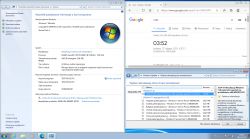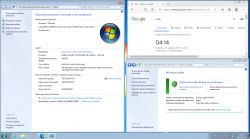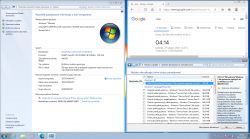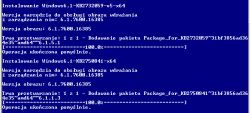Problems with google hosting have been resolved by migrating to another hosting .
As if there was something wrong with the link - please send me a PW.
Based on my experience of preparing "SP4" for Windows XP at the end of 2019, I have found it worthwhile to prepare a package for Windows 7 as support for it ended some time ago, and it is in my opinion one of the more successful systems from MS. If you are looking for an update for Windows XP, Windows 2000, Windows Server 2003, Office 2002 or 2003 I invite you here .
Behaviour of Windows Update on a clean system .
What's next for people without purchased extended support (ESU licence) - i.e. what about updates after 01.2020: .
Versions of the "SP2" package: *.msu and *.cab .
What the "SP2" package contains: .
What 'SP2' does not contain? .
Installation time of package "SP2" .
. Installation and download links .
State of Windows Update as of 27.02.2021 after installation of the package(without ESU license): .
.
As if there was something wrong with the link - please send me a PW.
Based on my experience of preparing "SP4" for Windows XP at the end of 2019, I have found it worthwhile to prepare a package for Windows 7 as support for it ended some time ago, and it is in my opinion one of the more successful systems from MS. If you are looking for an update for Windows XP, Windows 2000, Windows Server 2003, Office 2002 or 2003 I invite you here .
Behaviour of Windows Update on a clean system .
Spoiler:
.
By default on a clean Windows 7 with SP1 windows update limps along. It doesn't see the bulk update KB3125574 containing updates from SP1 to May 2016 at all, so it searches for single updates from this package (dozens of updates). It downloads several cumulative updates in a row, instead of the latest one (these monthly updates of several hundred MB). In addition, it keeps giving you errors when you want to install everything at once; you have to restart the system and try again until you get it right. Overall anguish and fun for several hours.
What's next for people without purchased extended support (ESU licence) - i.e. what about updates after 01.2020: .
Spoiler:
All post-support updates (except "Windows Malware Removal Tool" and Windows Defender definitions) are offered to those with an ESU (extended support) licence. Mainly these are bulk updates: system security, update stack, .NET packages (3.5.1 and 4.8), IE11. Bulk updates are released every certain period of time (usually a month), the next update overwrites the previous ones, so there are relatively few of them (the latest versions are instralled). Of course, you can download the packages, they will install themselves, but on restarting you will be shown a message such as "change rollback in progress" the computer will restart and the update will fail - just such an MS safeguard for not having a licence. Of course there are ways around this, but for obvious reasons I'll keep quiet about it (I don't even know if this hasn't been patched now, I haven't had a chance to try it out).
Versions of the "SP2" package: *.msu and *.cab .
Spoiler:
.
The versions with update files in *.msu and *.cab format have been prepared. The *.msu format has no advantages, it just shows that I downloaded the updates from the Microsoft Update Catalog and not from an unknown source.
Advantages of pure .*cab:
-minimally smaller file size,
-less disk space required for installation,
-fewer writes to disk during installation,
-faster performance (no decompression time needed).
The default installation type (e.g. by double-click) *.msu (wusa) is very slow (even with 2x or longer), so in both package types the *.cab archive contained in the *.msu file is installed using the dism tool. Simply the *.msu version is unpacked during installation, the *.cab version is already pre-extracted.
Advantages of pure .*cab:
-minimally smaller file size,
-less disk space required for installation,
-fewer writes to disk during installation,
-faster performance (no decompression time needed).
The default installation type (e.g. by double-click) *.msu (wusa) is very slow (even with 2x or longer), so in both package types the *.cab archive contained in the *.msu file is installed using the dism tool. Simply the *.msu version is unpacked during installation, the *.cab version is already pre-extracted.
What the "SP2" package contains: .
Spoiler:
.
-All system updates until the end of official support
-.NET Framework 4.8 (replaces all previous 4.x) with updates + .NET Framework 3.5.1 updates
-Internet Explorer 11 with updates
-Microsoft Edge (not actually required, but will be visible in Windows Update for download - if someone wants to they can just delete the installation file)
-Windows Defender definition updates from 26.02.2021 - here an interesting fact downloading the definition itself (and running it) from the MS website is not enough, Windows Update will still see the KB915597 update (but already under 1MB - this is the MpSigStub update downloaded by WU - source in the "SP2" package also WU "C:WindowsSoftwareDistributionDownload"). This update is not enough to simply run - you need to run it with the /Store parameter - then the file will copy itself to "C:WindowsSystem32".
Optional (enabled by default)
-Visual 2005-2019 redistribution packages (not required, can be disabled in the installer)
-.NET 1.1 with updates (not required, can be disabled in the installer)
-DirectX redistribution package with DirectX libraries mainly for older games (DX9/10) (latest version 2010) (not required, can be disabled in the installer)
Supposedly windows Update (erroneously) also searches for and installs updates that have been superseded by other, newer updates. I am aware that a couple of small updates may be unnecessary, however, when creating the package I was guided by the fact that windows Update does not search for any uninstalled updates. .
-.NET Framework 4.8 (replaces all previous 4.x) with updates + .NET Framework 3.5.1 updates
-Internet Explorer 11 with updates
-Microsoft Edge (not actually required, but will be visible in Windows Update for download - if someone wants to they can just delete the installation file)
-Windows Defender definition updates from 26.02.2021 - here an interesting fact downloading the definition itself (and running it) from the MS website is not enough, Windows Update will still see the KB915597 update (but already under 1MB - this is the MpSigStub update downloaded by WU - source in the "SP2" package also WU "C:WindowsSoftwareDistributionDownload"). This update is not enough to simply run - you need to run it with the /Store parameter - then the file will copy itself to "C:WindowsSystem32".
Optional (enabled by default)
-Visual 2005-2019 redistribution packages (not required, can be disabled in the installer)
-.NET 1.1 with updates (not required, can be disabled in the installer)
-DirectX redistribution package with DirectX libraries mainly for older games (DX9/10) (latest version 2010) (not required, can be disabled in the installer)
Supposedly windows Update (erroneously) also searches for and installs updates that have been superseded by other, newer updates. I am aware that a couple of small updates may be unnecessary, however, when creating the package I was guided by the fact that windows Update does not search for any uninstalled updates. .
What 'SP2' does not contain? .
Spoiler:
.
-KB4493132 - this is the update that displays the end of support message. Another message with the same message was in another update anyway so it will show up (we give do not remind again), and the absence of this update is due to the fact that it is not in the Microsoft Update Catalog, and the version downloaded and installed via Windows Update (*.cab file) cannot be installed separately (EXPRESS version). Small loss, anyway, the update does not affect anything and is marked as optional.
-Language packs (for higher versions of Windows 7 (this is not available in Home, for example)) - I don't think I need to explain, also optional and probably nobody uses it.
-Late updates requiring an ESU licence.
-Language packs (for higher versions of Windows 7 (this is not available in Home, for example)) - I don't think I need to explain, also optional and probably nobody uses it.
-Late updates requiring an ESU licence.
Installation time of package "SP2" .
Spoiler:
On a computer with specs:
-Intel Xeon E5-1660 @4.3GHz
-16GB RAM
-NVMe 1TB WD SN750
And VMWare virtual machines (4 cores, 4GB RAM, 60GB HDD), when running the update side-by-side for 32-bit and 64-bit the installation time was:
32 minutes for the 32-bit version
48 minutes for the 64-bit version
For the *.msu versions, 2 minutes each can be added to these times. Installation on physical hardware with any SSD will mainly be limited by the performance of the single threaded CPU (TrustedInstaller uses 1 thread). Times on HDD will probably increase significantly. Maybe I'll add times on other, physical machines later.
-Intel Xeon E5-1660 @4.3GHz
-16GB RAM
-NVMe 1TB WD SN750
And VMWare virtual machines (4 cores, 4GB RAM, 60GB HDD), when running the update side-by-side for 32-bit and 64-bit the installation time was:
32 minutes for the 32-bit version
48 minutes for the 64-bit version
For the *.msu versions, 2 minutes each can be added to these times. Installation on physical hardware with any SSD will mainly be limited by the performance of the single threaded CPU (TrustedInstaller uses 1 thread). Times on HDD will probably increase significantly. Maybe I'll add times on other, physical machines later.
. Installation and download links .
Spoiler:
.
The installation is fully automated. Once the installation has started, everything goes automatically, if you need to move on to the next stage of the installation, the computer is restarted and the installation continues. This is because it is impossible to install all the updates at once. And so I think that an installation split into 3 stages is still quite an achievement.
In order to install, the following is required:
-Windows 7 (32-bit or 64-bit) with Service Pack 1.
-Administrator type account (not the built-in account named Administrator), this is due to having higher privileges and using the RunOnce registry entry used to continue installation of subsequent stages (also with administrator privileges) after a reboot. By default, an Administrator type account is created when installing the system.
The installation script will check that it has been run with administrator privileges and that SP1 is installed. If either criterion is not met, the script will display an error and exit. Generally, only the install.bat file is available for the end user to run, the scripts in the scripts directory are called automatically during installation. The order used and the division into stages preclude any conflict. Before installation, it is advisable to disable automatic updates for the duration of the installation and to ensure that no installation (of updates or anything else) is running in the background.
The download package is an *.iso image to be burned to disc. On windows 7 it can be unpacked using 7-zip. The package can be placed in any location, but it is important that the path to the files is the same on reboot (when using a virtual drive on reboot, the file may not be mounted quickly enough, the USB drive letter may change if we disconnect another USB drive during installation, etc.).
Version *.cab:
Windows 7 SP2 32-bit: Link .
Windows 7 SP2 64-bit: Link .
*.msu version:
Windows 7 SP2 32-bit: Link .
Windows 7 SP2 64-bit: Link .
Courtesy of the host of the WinISO.co.uk website, you can also use the mirror, and you can find a copy of this topic posted there with my permission.
Version *.cab (mirror) :
Windows 7 SP2 32-bit: Link .
Windows 7 SP2 64-bit: Link .
Version *.msu (mirror) :
Windows 7 SP2 32-bit: . Link .
Windows 7 SP2 64-bit: Link .
In order to install, the following is required:
-Windows 7 (32-bit or 64-bit) with Service Pack 1.
-Administrator type account (not the built-in account named Administrator), this is due to having higher privileges and using the RunOnce registry entry used to continue installation of subsequent stages (also with administrator privileges) after a reboot. By default, an Administrator type account is created when installing the system.
The installation script will check that it has been run with administrator privileges and that SP1 is installed. If either criterion is not met, the script will display an error and exit. Generally, only the install.bat file is available for the end user to run, the scripts in the scripts directory are called automatically during installation. The order used and the division into stages preclude any conflict. Before installation, it is advisable to disable automatic updates for the duration of the installation and to ensure that no installation (of updates or anything else) is running in the background.
The download package is an *.iso image to be burned to disc. On windows 7 it can be unpacked using 7-zip. The package can be placed in any location, but it is important that the path to the files is the same on reboot (when using a virtual drive on reboot, the file may not be mounted quickly enough, the USB drive letter may change if we disconnect another USB drive during installation, etc.).
Version *.cab:
Windows 7 SP2 32-bit: Link .
Windows 7 SP2 64-bit: Link .
*.msu version:
Windows 7 SP2 32-bit: Link .
Windows 7 SP2 64-bit: Link .
Courtesy of the host of the WinISO.co.uk website, you can also use the mirror, and you can find a copy of this topic posted there with my permission.
Version *.cab (mirror) :
Windows 7 SP2 32-bit: Link .
Windows 7 SP2 64-bit: Link .
Version *.msu (mirror) :
Windows 7 SP2 32-bit: . Link .
Windows 7 SP2 64-bit: Link .
State of Windows Update as of 27.02.2021 after installation of the package(without ESU license): .
.








